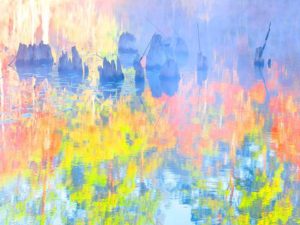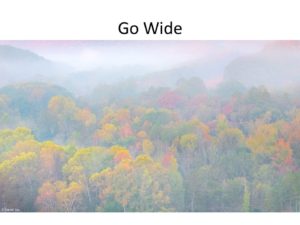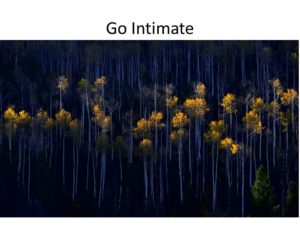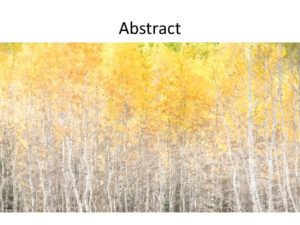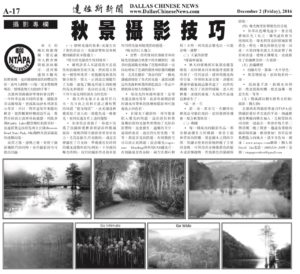秋天的楓紅旖旎燦爛,總是贏得人們青睞與痴迷的關注。見到那連綿不斷的紅橙黃綠,見到那層層起伏的豐富色彩,直叫人倒吸一口氣,更不禁輕聲喝彩,感嘆造物主幻化的手筆!
北德州亞裔攝影學會的會員們,一年四季追逐不同的景象,親臨許多活動現場,更或跋山涉水尋訪名山奇景。所以,對於這每年來臨的秋景,絕對抓緊時機創造作品。我們在社區公園裡尋找靈感,到凱多湖(Caddo Lake)觀賞轉紅的落羽杉,也遠征奧克拉荷馬州立公園(Beavers Bend State Park, OK)陶醉在清晨霧起的迷離幻境。
欣賞之餘,感嘆之後,在按下攝影機快門的同時,有些攝影技巧可提出討論。
(I) Know the Light
* Overcast
…Your lighting play a huge role on the vibrancy of color when photographing fall foliage. While many don’t consider an overcast day to be the best lighting foliage photography, it’s an incredible way to capture the saturated colors of leaves. Overcast lighting has the ability to eliminate harsh shadows and highlights – and in the process, bring out those powerful tones and colors that aren’t visible under the sun.
…Overcast lighting is not just for daytime – the blue hours (that small window after sunset and before sunrise) can add a stunning blue/purple hue to fall foliage, with all the benefits of overcast lighting listed above.
…If you’re a night owl, you don’t have to get up at 4am to capture the fall foliage – night time overcast photos are incredibly powerful, especially when the moon is new (not visible) or there is cloud coverage. While you’ll have to employ long exposure techniques (be prepared for 10 minute shutter speeds), the result is an evenly-lit photo, but with a surreal sense to it.
(一) 瞭解光線的效果 – 光線左右了顏色的活力,光線影響秋景和秋葉的攝影更不餘遺力。
* 陰天的光線產生特別效果:
• 雖然許多人不認為陰天是最佳的拍攝秋景的天氣,然而陰天具有一種特殊效果,更能顯現秋葉的飽合顏色。陰天,正因為雲層擋住了太陽,避免了陽光所產生的粗硬的高光和陰影,也因此呈現了陽光下所不易見到的強有力的色彩。
• 陰天的光線不止適用於白天,在日出之前和日落之後短暫的所謂“藍光時段”,此光線為秋葉添加了迷人的一股藍色或一絲紫光,更何況還含有上述的優點。
• 如果你是夜貓子,你就不需為了拍攝秋葉秋景而清晨四點鐘起床。夜晚的陰天攝影效果非常有力,尤其是新月(月光微弱),或是雲層擋住了月光時。準備運用長時間的曝光設備和技巧(例如,十分鐘的曝光時間),收到的攝影作品效果是均勻的光線和超現實的感覺。
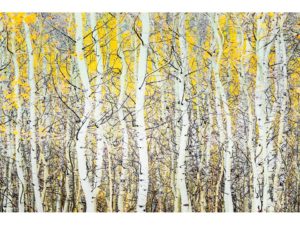
* Sunlight
…Of course, nothing can beat those warm tones of the sun combined with the incredible color of autumn. The more direct lighting gives you an increase of shadows and highlights which expands the tonal range and drama of an image. In particular, the golden hours have the ability to flood your lens with visible rays of sun – combine this with the foliage color, and you’re in for an incredibly powerful photo.
…Looking for light direction and strength, backlight or sidelight, overhead strong light create strong shade and wash out color
…When shooting under the sun, you’ll undoubtedly run into exposure problems – especially in the morning and evening when the angle of the sun gives you more highlights and shadows to work with. An overexposed sky, underexposed ground, or blown highlights from reflections are all common issues that you may encounter.
– To rectify this, you have two main options – exposure blending or using GND filters. If you’re taking photos of landscapes, you can use either method – if not, then exposure blending will be your best bet.
* 陽光的巨大魔力
• 當然,沒有任何比溫暖柔和的陽光更能融合秋葉中的各種顏色。越多的直接陽光增加了亮點和陰影,也因此增加了色調的限度和影像的戲劇性。尤其在攝影“黃金時段”,陽光讓鏡頭捕捉了各式的光線,適當地將這些光線和秋葉的顏色混合,作品中將能具有極大的爆發力。
• 尋找光的來源和強度,是背光還是側光等等。也許要避開當頭的強光所帶來的強硬的陰影和可能會洗去的色彩。
• 在陽光下攝影時,很可能會陷入曝光的問題,這在清晨和黃昏那斜射的光線角度增加了光影的影響時,也會發生。過曝的天空、過暗的地景、過亮的反射光點,等等,都是常見的問題。有兩個技巧可以糾正此問題:混合曝光(exposure blending)和利用GND濾光片。在拍攝風景作品時,兩方法都可利用;不然,利用混合曝光法,可能是唯一選擇。
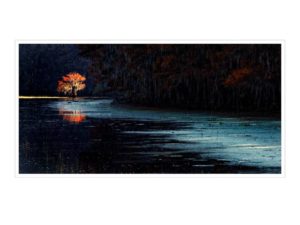
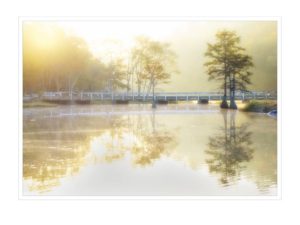
(II) Weather
* Mist & Fog
Not only is autumn a show of color, but those cold nights allow for many misty mornings. Fog on water and thick mist in the air can provide a stunning composition – combine this with the light of the golden hours, and you can create an outstanding autumn landscape
* Frost & Ice
Also keep in mind that autumn mornings are often laden with frost from the sudden drop in overnight temperatures
(二) 天氣的影響
* 薄霧和霧氣
秋天的夜晚經常氣溫也隨著降低,此時湖水河水的溫度也跟著冷卻了,待到清晨,暖和的陽光與冷空氣、冷卻的水面交接,迷樣的薄霧和霧氣就這麼升起了。此時的構圖,配合了斜射的暖陽、迷人的秋葉、迷樣的霧氣,大氣的作品就這麼產生了。
* 霜、冰、雪
霜、冰、甚至雪,在驟冷的秋夜是可能出現的,記得緊抓住機會,配合秋葉取景。
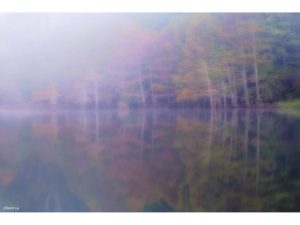
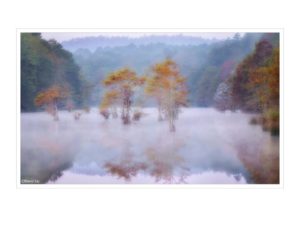
(III) Composition
Every great image needs a clean and clear composition. Look for good spacing between trees so that key shapes don’t merge together. Consider using other trees, such as evergreens or trees that are still green, for better color balance and contrast. Eliminate distracting elements that don’t contribute to the main subject.
(三) 構圖
每一個成功的攝影作品,都有個清潔有力的構圖。留意主題和背景的距離,留意樹木之間的空間,別讓不想要的景物干擾了主要的景物。可利用尚未轉換顏色的樹木或常綠植物,作為顏色的協調與搭配。
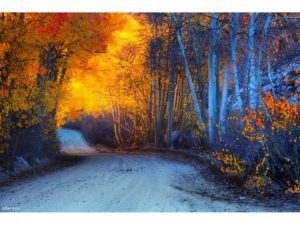
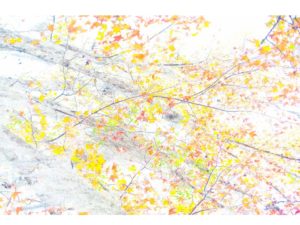
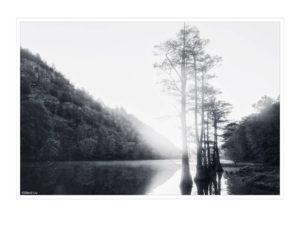
(IV) Exposure
If you underexpose red, it will become a deep maroon red; overexpose red, and it will become pink. The same goes for colors like orange and yellow. If you miss exposures on these colors, you’ll lose a big part of your autumn scene. Learn how to expose scenes like this and your autumn landscapes will improve.
(四) 曝光程度影響顏色的呈現
如果紅色曝光過少,會呈現紫褐紅色;反之,曝光過度會呈現粉紅色。曝光程度也同樣地影響黃色、橙色、綠色的顏色呈現。因此,不當的曝光就大大地影響了秋景的表達。瞭解正確曝光,也就抓住了拍攝秋景的一大祕訣。
(V) Shooting Ideas
* Water Reflection
Shoot autumn color reflected in water to create stunning abstract fall photos. These shots work best early or late on a sunny day. Ideally, you want reflected foliage to be sunlit and the rest of the scene to be in shade. If you have lots of yellows, oranges and reds on the trees, you’ll end up with beautiful warm tones reflected in water and on wet surfaces. Objects in shade (such as river rocks and rapids) are lit only by light reflecting from the blue sky above, rendering them blue. By mixing the two types of light, warm and cool, you can get a lovely blend of colors. Experiment with white balance until you find a setting that optimizes reds, yellows and oranges, yet at the same time retains some of the blues as well. Try the Daylight setting (about 5500K) or slightly cooler (I sometimes go as low as 4500K) to get the right look. A polarizer can make your autumn reflection photos pop, but avoid full polarization, which removes reflections entirely. Partial polarization enhances the colors in your reflection scene. A telephoto zoom works best to create tight-cropped images; a 70-200mm lens often will get you close enough, although a 100-400mm is even better. Try to create compositions that feature a pleasing arrangement and juxtaposition of colors surrounding an attractive set of rapids or river rocks. With reflection photos, abstract and impressionistic images often work best, so zooming in tight on just a few key details can make all the difference. Because you’re working with moving water, consider using longer shutter speeds to create motion blur; a half-second or longer will give your images a dreamy, impressionistic look, merging and swirling colors and creating a silky look in the water. Experiment freely until you get the effect you want.
(五) 拍攝構想
• 拍攝大景,抓取一大片景色。
• 與景物貼近,拍取精彩的一面。
• 採抽象手法,拍攝水面倒影、故意震動相機、故意過曝、故意失焦、等等。
